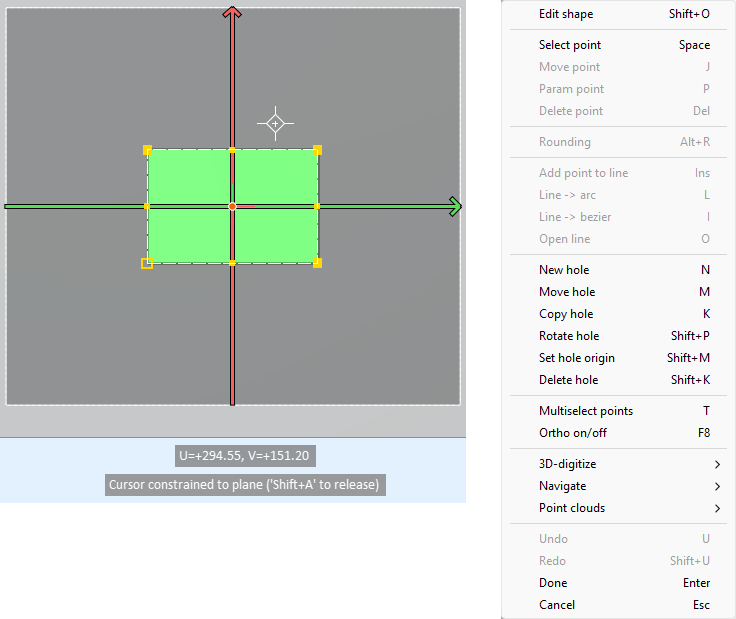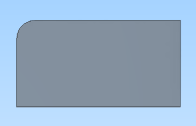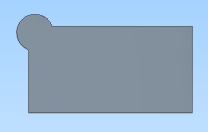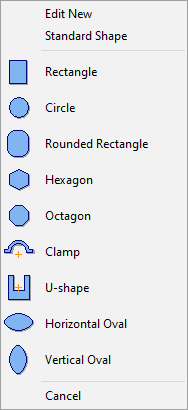Edit

On the Structural tab, in the Plate group, the Edit tool allows you to change the shape of a plate created with the Insert tools of Plant Modeller and to define holes in the plate.
Note: Editing a plate that has been created in Component Modeller is described in Component Model.
Plate editor
Picking a plate with the Edit tool activates the editor interface of the cross section of that plate. When the editor is active, right-clicking the view displays a context menu where you can find the tools described in Plate editor context menu.
You can see the following:
-
Control points and line segments that define the shape of the object.
-
Plate's main axes (U, V).
-
Cursor's distance from the origin of the plate in U (horizontal) and V (vertical) direction.
If you accidentally edit the curves so that they intersect each other, you can see an error message below the U and V coordinates:

Plate editor context menu
Right-clicking a view when the plate editor is open displays the following tools.
Point tools
You can use the following tools when you have selected a control point or line segment, except Param point only works for control points.
| Command | Shortcut | Description |
|---|---|---|
|
Space |
Selects the control point or line handle that is nearest to the cursor. Then you can select some other tool to use it on the selected item. If Multiselect points is enabled, you can select more than one control point. |
|
|
J |
Allows moving the selected control points or line segment. |
|
|
P |
Opens a dialog for defining parameters for the selected control point. |
|
|
Del |
Deletes the selected control points or line segment. |
Rounding tool
You can use the following tool when you have selected a corner of the plate.
| Command | Shortcut | Description |
|---|---|---|
|
Alt+R |
Opens the Select Rounding dialog for adding rounding to the selected corner or to remove an existing rounding. For details, see Editing a plate. |
Line tools
You can use the following tools when you have selected a control point or line segment.
| Command | Shortcut | Description |
|---|---|---|
|
Ins |
Inserts a control point to the center of the selected line. |
|
|
L |
Converts the selected line into an arc. You are prompted to select the direction of the curve. |
|
|
I |
Converts the selected line into a Bézier curve and insert two control points for changing the shape of the curve. |
|
|
O |
Creates a gap in the plate's contour by removing the selected line segment, after which you can pick one or more new control points and press Enter to close the contour again. |
Hole tools
You can use the following tools to define holes in the plate.
| Command | Shortcut | Description |
|---|---|---|
|
N |
Creates a new hole. For details, see Defining holes. |
|
|
M |
Moves the selected hole to the current location of the cursor. |
|
|
K |
Makes a copy of the selected hole and places the new hole at the current location of the cursor. |
|
|
Shift+P |
Opens the Rotate Hole dialog for rotating the selected hole. |
|
|
Shift+M |
Opens the Parameterize dialog for defining the origin (U, V) of the selected hole. |
|
|
Shift+K |
Deletes the selected hole. |
Other tools and options
| Command | Shortcut | Description |
|---|---|---|
|
Shift+O |
Opens the Parameterize dialog for editing the parameters of a Standard Shape. |
|
|
T |
When this option is enabled, you can select several control points, one by one, and then use a tool such as Move point on the selected points. |
|
|
F8 |
When this option is enabled, points and lines can only be moved in either horizontal or vertical direction. If the option is enabled and you select the midpoint of a line, you can only move the line forward (extend the section) or backward (shorten the plate). If the option is disabled and you select the midpoint of a line, you can move the line in any direction, which can rotate the plate or change its shape. |
|
|
F6 |
Moves the cursor to the nearest grid point. |
|
|
F7 |
Shows or hides the grid. The grid can be customized in the settings. |
|
|
F9 |
Enables or disables the snapping. The snap distance can be defined in the settings. |
|
|
F10 |
Opens the Snap and Grid dialog for defining the snap and grid settings. See Defining snap and grid settings. |
|
|
U |
Use this command to undo previous actions, one at a time. |
|
|
Shift+U |
Use this command to redo previously undone actions, one at a time. |
|
|
Enter |
Accepts the changes and closes the editor. |
|
|
Esc |
Cancels the changes and closes the editor. |
Editing a plate
You can edit the shape of a plate in the 3D model.
Do the following:
-
On the Structural tab, in the Plate group, click Edit.
-
Pick the plate that you want to edit and press Enter.
-
You can add rounding to individual corners or remove previously added rounding. You cannot edit the rounding of a plate that has been inserted as a Rounded Rectangle.
 Show/hide details
Show/hide details
-
Click near the corner to be rounded, so that the corner point is activated but not selected for moving.
-
Press Alt+R to activate the Rounding command. The Select Rounding dialog opens.
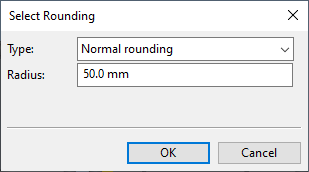
-
Do one of the following:
-
To insert a normal rounding, select Normal rounding and specify the radius.
-
To insert a rounding with an offset, select Mickey Mouse rounding, specify the radius, and specify the offset from the corner point.
-
To insert a rounding on one side of the corner, select One-sided rounding and select the side.
-
To remove rounding, select No rounding.
-
-
Click OK. The rounding is applied to the specified corner. You can continue adding rounding to other corners in the same way.
-
-
You can manipulate line segments.
 Show/hide details
Show/hide details
-
You can select a line by clicking (or pressing Space) near the line segment. Then you can use the tools described in Line tools.
-
You can directly start moving a line by clicking the handle of the line.
-
You can edit a straight line segment:
-
You can insert new control points with Add point to line and then move those points as required.
-
You can turn a straight line into a curve with Line -> arc or Line -> bezier.
-
You can remove a line segment with Open line and then close the gap by adding one or more new line segments.
-
-
You can delete the selected line by pressing Delete.
-
-
You can manipulate control points.
 Show/hide details
Show/hide details
-
You can select one control point by clicking near the point. Then you can use the tools described in Point tools.
-
You can directly start moving a control point by clicking the point.
Tip: You can enable Ortho on/off to limit the movement to horizontal or vertical direction.
-
You can select multiple control points if you first enable the Multiselect points option and then click near the points that you want to select.
-
You can delete the selected points by pressing Delete.
-
-
You can add holes to the plate as described in Defining holes and manipulate existing holes with Hole tools.
-
Press Enter to accept the changes and close the editor.
Defining holes
You can add holes to a plate in the 3D model.
Do the following:
-
On the Structural tab, in the Plate group, click Edit.
-
Pick the plate that you want to edit and press Enter.
-
Move the cursor to the intended location of the hole.
-
Press N to activate the New hole command. The shape menu opens.
-
You can create a hole whose shape is completely user-defined. The inserted hole has editable control points, so the shape can be changed also later.
 Show/hide details
Show/hide details
-
In the shape menu, click Edit New.
-
Define the shape of the hole by picking control points on the plate and using the commands in the context menu.
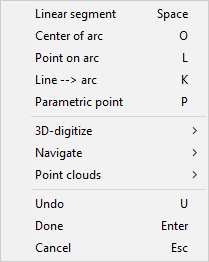
-
To complete the shape, move the cursor near the starting point and press Enter.
-
-
You can create a hole whose shape is completely predefined and size parameters are defined during the insertion. After the insertion, the size parameters can be adjusted with Edit shape.
 Show/hide details
Show/hide details
-
In the shape menu, click Standard Shape. The Select standard shape dialog opens.
-
Click the name of the shape you want to use. The Parameterize dialog opens.
-
Define the size parameters and click OK. The hole is inserted to the plate.
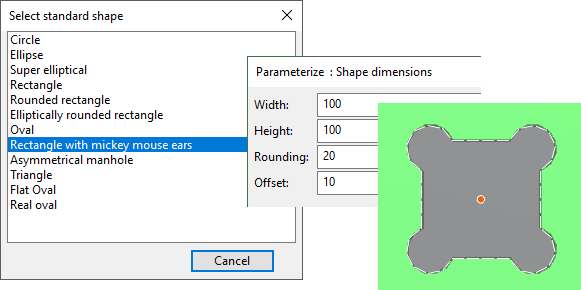
-
-
You can create a hole whose initial shape is predefined and size parameters are defined during the insertion. After the insertion, the shape can be freely changed by manipulating the control points and line segments.
 Show/hide details
Show/hide details
-
In the shape menu, click the name of the shape that you want to use. The Parameterize dialog opens.
-
Define the size parameters and click OK. The hole is inserted to the plate.
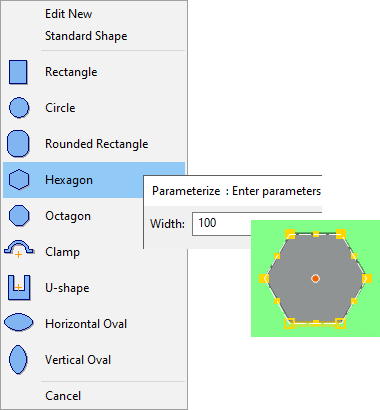
-
-
You can change the shape and/or the size of the hole as allowed by the shape type you selected for the hole.
-
You can change the location of the selected hole with Move hole or Set hole origin.
-
You can create additional holes by making copies of an existing hole with Copy hole.
-
When you have defined the required holes, press Enter to create the holes in the plate and close the editor.
Defining snap and grid settings
You can set the grid to be shown or hidden and choose whether the cursor moves freely or a specific distance at a time. Only rectangular grids are supported.
Do the following:
-
Right-click the plate editor and select Navigate > Grid and Snap settings. The Snap and Grid dialog opens.
-
Define the settings:
-
Show Grid [F7] – Select this option to show the grid.
-
Show as Lines – Select this option to show the grid as lines instead of dots.
-
Use Snap [F9] – Select this option to set the cursor to move according to the snap spacing settings.
-
Color – Select the color of the grid.
-
Grid spacing U, Grid spacing V – Specify the grid spacing in horizontal and vertical direction in millimeters.
-
Snap spacing – Specify the snap interval in horizontal and vertical direction.
-
Base U, Base V – Specify the base point to use for grid and snap, in horizontal and vertical direction.
-
-
Click OK.
